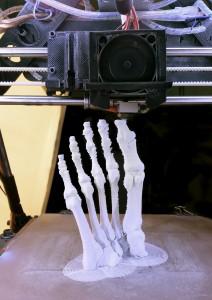 3D printing is becoming a pretty player in the medical industry, with 3D printed prosthetics, surgical models, and implants being used with increasing regularity in hospitals, dental offices, and clinics. With new technology, of course, comes new regulation. The Institute of Electrical and Electronics Engineers Standards Association (IEEE-SA) has recently unveiled new interoperability standards for 3D printers and other electronic devices used in the medical field. They also announced that they will be collaborating with the Regenstrief Institute, the Indiana-based informatics and healthcare research organization, to develop standardized usage of medical terminology in device communications.
3D printing is becoming a pretty player in the medical industry, with 3D printed prosthetics, surgical models, and implants being used with increasing regularity in hospitals, dental offices, and clinics. With new technology, of course, comes new regulation. The Institute of Electrical and Electronics Engineers Standards Association (IEEE-SA) has recently unveiled new interoperability standards for 3D printers and other electronic devices used in the medical field. They also announced that they will be collaborating with the Regenstrief Institute, the Indiana-based informatics and healthcare research organization, to develop standardized usage of medical terminology in device communications.
IEEE-SA is currently developing IEEE P3333.2.5 Draft Standard For Bio-CAD File Format for Medical Three-Dimensional (3D) Printing, which will standardize the Bio-CAD file format used in the printing of prosthetics, models and other medical devices.
“High reliability in producing useful and cost-effective products is especially important in medical 3-D printing,” the IEEE stated. “When completed, the standard is intended to address medical 3-D printing services, such as anatomic and pathologic models and medical-instrument printing.”
IEEE P.333.2.5 comes on the heels of another 3D printing-related standard, IEEE P3030, which defines an architectural framework for consumer 3D printing and was introduced in September.
“Consumer 3D printing technology is emerging rapidly and there is a need to incentivize industry adoption of standards specific to the marketplace, and to be cognizant of unique challenges where 3D printed items from a wide range of future equipment will need to produce identical results in order to achieve broader market acceptance,” Yu Yuan, chair, IEEE Consumer 3D Printing Working Group, said at the time. “IEEE P3030 is focused on standards development to establish quality metrics and accuracy grades so that printed materials at the consumer level can be assembled faultlessly, while also addressing issues related to privacy, security and control measures.”
In conjunction with the Regenstrief Institute, which operates the Logical Observation Identifiers Names and Codes database of universal medical terminology, a Memorandum of Understanding has been signed to develop standard medical terminology for the purpose of interoperability between point-of-care personal health devices as defined in IEEE 110073 Standards for Medical Device Communication. IEEE-SA will also be collaborating with the National Institute of Standards and Technology to further develop IEEE 110073.
“The IEEE-SA’s efforts in eHealth are all focused on expanding interoperability standards and supporting the growth of the eHealth ecosystem and new life-saving capabilities,” said Konstantinos Karachalios, managing director at IEEE-SA. “Through both standardization and collaboration, the IEEE-SA strives to improve the quality of eHealth and the wellbeing of people worldwide by providing a global platform for eHealth stakeholders across regions and technologies to openly collaborate and build consensus. The new partnership and standardization milestones that we are announcing today are evidence of this effort.”
With electronic medical devices, including medical 3D scanners and printers, that can easily transmit data back and forth, security becomes an obvious concern. IEEE-SA will also be addressing data security with IEEE 2410-2015 Standard for Biometrics Open Protocol, which will establish secure servers for the transmission of data and include systems for the detection of outside intrusions. With the new standards in place, 3D printing continues to secure and solidify its place as one of the leading facets of electronic medical technology. Discuss this story in the IEEE 3D Medical Printing forum thread on 3DPB.com.
[Images: IEEE.org]Subscribe to Our Email Newsletter
Stay up-to-date on all the latest news from the 3D printing industry and receive information and offers from third party vendors.
You May Also Like
3D Printing Financials: Steakholder Foods Balances Losses and 3D Printed Tech Advances in 2023
A pioneer in the field of 3D printed meat and fish, Steakholder Foods (Nasdaq: STKH) disclosed its 2023 financial results, a year highlighted by technological progress but overshadowed by financial...
3D Printing Financials: Protolabs’ Q1 3D Printing Revenue is Flat, Company Advances in Technology Push
Protolabs (NYSE: PRLB) has kicked off 2024 with a mild boost in revenue, revealing how the Minnesota-based company manages to adapt and thrive even in uncertain market conditions. While the...
Supply Chain Management and the Role of 3D Printing Digital Inventories
As the additive manufacturing (AM) industry grows beyond its humble roots as a rapid prototyping technology, it has been adopted by some of the world’s leading companies to produce not...
3D Printing Financials: Materialise’s Profitability Amid Revenue Dip in Q1 2024
Materialise (Nasdaq: MTLS) has released its first-quarter earnings for 2024, highlighting a challenging quarter with some key advances despite a dip in revenue. While navigating a mixed performance across its...

































